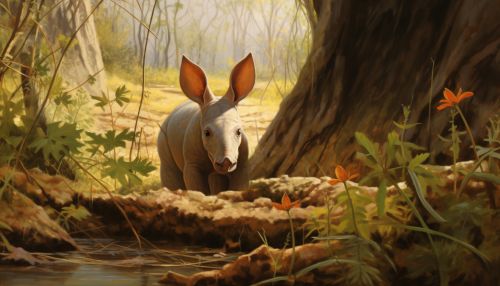Aardvark
Overview
The Aardvark (Orycteropus afer) is a medium-sized, burrowing, nocturnal mammal native to Africa. It is the only living species of the order Tubulidentata, although other prehistoric species and genera of Tubulidentata are known. Unlike other insectivores, it has a long pig-like snout, which is used to sniff out food. It roams over most of the southern two-thirds of the African continent, avoiding areas that are mainly rocky. A nocturnal feeder, it subsists on ants and termites, which it will dig out of their hills using its sharp claws and powerful legs. It also digs to create burrows in which to live and rear its young.


Taxonomy and Evolution
The aardvark is not closely related to the South American anteater, despite sharing some characteristics and behaviors. The similarities are due to convergent evolution. The closest living relatives of the aardvark are the elephant shrews, along with the sirenians, hyraxes, tenrecs, and elephants. Together, these animals form the superorder Afrotheria.
Anatomy and Morphology
The aardvark is vaguely pig-like in appearance. Its body is stout with an arched back and is sparsely covered with coarse hairs. The limbs are of moderate length. The front feet have lost the pollex (or 'thumb'), resulting in four toes, while the rear feet have all five toes. Each toe bears a large, robust nail which is somewhat flattened and shovel-like, and appears to be intermediate between a claw and a hoof.
Behavior and Ecology
Aardvarks are solitary creatures that feed almost exclusively on ants and termites. The only fruit eaten by aardvarks is the aardvark cucumber. An aardvark emerges from its burrow in the late afternoon or shortly after sunset, and forages over a considerable home range encompassing 10 to 30 kilometres. While foraging for food, the aardvark will keep its nose to the ground and its ears pointed forward, indicating that both smell and hearing are involved in the search for food.
Reproduction and Lifecycle
Aardvarks pair only during the breeding season; after a gestation period of seven months, one cub is born, and it is able to leave the burrow to accompany its mother after only two weeks, and is eating termites at 14 weeks, and is weaned by 16 weeks. The young aardvark stays with its mother until the next mating season, and digs its own burrow at about six months of age.
Conservation
The aardvark is listed as least concern by the International Union for Conservation of Nature (IUCN). Its numbers are stable, and it is not significantly threatened by hunting for bushmeat, but it is increasingly threatened by agricultural activities.
